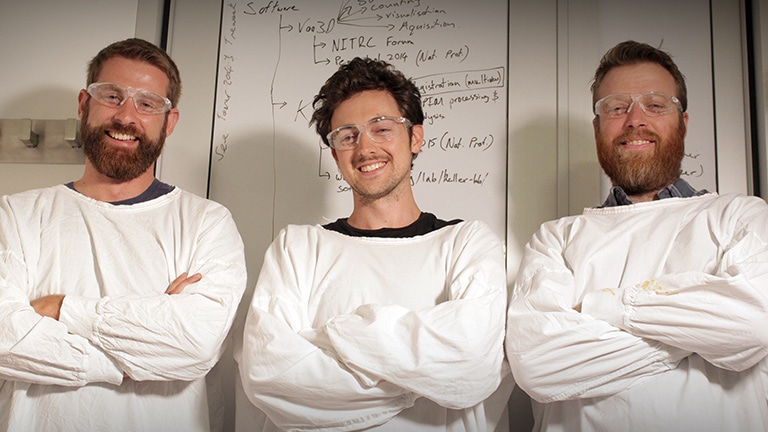
Three young University of Newcastle (UON) biologists have hand-built a state-of-the-art laser microscope at HMRI that delivers clear three-dimensional cellular images with unparalleled speed and precision.

Three young University of Newcastle (UON) biologists have hand-built a state-of-the-art laser microscope at HMRI that delivers clear three-dimensional cellular images with unparalleled speed and precision.
Where commercial versions cost up to $1 million, colleagues Dr Jamie Flynn, Antony Martin and Will Palmer assembled their unique device for just $70,000 using plans, parts and technical advice sourced from the internet and collaborators around the world.
Known as the “CLARITY light-sheet”, it was built as a communal resource for all HMRI-aligned researchers and will potentially revolutionise research across a myriad of disease areas, with studies for cancer, asthma, stroke, gastroenterology and reproduction already planned.
“A traditional microscope looks at a thin veneer that has been sliced off the original sample. With the CLARITY light-sheet we can now see the same microscopic level of detail in the whole 3D sample, plus we can rotate it which is impossible on standard microscopes,” Antony Martin said.
“It’s also much faster, which saves money. It was taking hours to get one image using the old technology – this system takes a few minutes and doesn’t harm the sample.”
Dr Flynn learnt of the technology during a lecture at Stanford University, California, and then joined an international community of scientists sharing open-source design information.
“The blueprints came from a group in Dresden, Germany, but we doubled everything, including the number of lasers, and added design elements to make it more user-friendly and functional,” Dr Flynn explained.
“It’s a customised, one-of-a-kind unit … and being modular, it can be upgraded as required. We tailor the microscope around the sample instead of manipulating the sample to fit inside a standard microscope.”
The team had ample knowledge in using microscopes but no prior optical engineering experience. They “learnt on the job”, altering the light paths numerous times before settling on the final configuration. Parts were sourced from all over the world, including optical components and a table from the US, a camera from Japan, and bespoke-built parts from South Africa.
“We had biological questions to answer, but the technology wasn’t there,” Dr Flynn added. “Light sheet technology is now evolving so fast because life sciences are moving to high-resolution 3D imaging. This is cutting-edge technology where everyone knows the potential, and now Newcastle is part of a very select scientific community with this technology.”
clarity-low-resWill Palmer said the CLARITY light-sheet technology coincided with the development of new techniques for treating organ samples before they go into the microscope.
“There’s been a convergence with the technique of ‘clearing out’ samples,” Mr Palmer said. “Organ samples actually become clear to the naked eye – you can’t see them in the tube – but all of the molecular information, like DNA, is trapped within the tissue. We can then label it with our molecular probes.”
Joint funding for the CLARITY project was provided by HMRI Life Governor Jennie Thomas AM and the Newcastle Permanent Charitable Foundation.
“We were having our normal meeting with the young researchers I work with when Jamie started to tell us about his dreams for the CLARITY microscope,” Jennie Thomas said. “It was something out of the blue and we all just sat there and went ‘Wow!’
“I decided right there and then that it was a real goer for HMRI and all the researchers, and something I had to support.” Newcastle Permanent Charitable Foundation Chairman Michael Slater said: “The Foundation is very pleased to support HMRI’s work by helping to fund the light-sheet microscope.
“The application of the new technology has the potential to improve health outcomes for those in our community battling diseases we don’t yet understand, and to assist researchers to develop treatments and possibly cures for diseases affecting thousands of Australians.”
* Dr Jamie Flynn, Antony Martin and Will Palmer are from the University of Newcastle, researching in conjunction with HMRI. HMRI is a partnership between the University of Newcastle, Hunter New England Health and the community.
HMRI would like to acknowledge the Traditional Custodians of the land on which we work and live, the Awabakal and Worimi peoples, and pay our respects to Elders past and present. We recognise and respect their cultural heritage and beliefs and their continued connection to their land.

Hunter Medical Research Institute
We’re taking healthy further.
Locked Bag 1000
New Lambton
NSW, Australia, 2305



This site is protected by reCAPTCHA and the Google Privacy Policy and Terms of Service apply.
Copyright © 2024 Hunter Medical Research Institute | ABN: 27 081 436 919
Site by Marlin Communications
